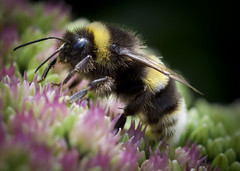If you are one of the hundreds, if not thousands, of people who got to watch Jerry Seinfeld lend his voice to the lovable Berry B. Benson in The Bee Movie, you’re probably aware of the massive ecological affect bees have on the environment. But in case you’ve been living under a rock, you should know that bees, honey bees and bumble bees included, are responsible for pollinating more than a third of the food we shove into our mouths. In case you’re more of a numbers person, that means bees rake in about 1.2 billion dollars for people in just the US alone. And if you already knew this, you’re probably also aware of the fact that bees have been declining at pretty alarming rates, probably for multiple reasons. For bumble bees specifically, one of the major causes of mortality is the spread of pathogens from captive-bred bees to wild bees.

Wild bumblebees may be contracting diseases from captive bees. Photo courtesy of University of Illinois at Urbana.
A study published recently by researchers at the University of Notre Dame documents the results of a sampling of bumble bees in Michigan for the fungus known as Nosema bombi. This nasty pathogen is found in the gut and excretory organs of bees and has major negative consequences in terms of individual fitness. Bees infected with Nosema bomi have higher death rates, lower reproductive success, and when they do manage to reproduce, often have deformed offspring. Researchers at Notre Dame set out to see if bees in Michigan were infected with Nosema bombi, and if so, wanted to know if the use of pesticides on farms made them any more susceptible to it. They captured 232 bees in total from 9 different farm sites.
The good news is that none of the bees they sampled were infected with Nosema bombi, which is an encouraging sign for the bumble bee population of Michigan. The bad news, from a scientific perspective, is that the researchers did not get to test their hypothesis regarding the use of pesticides on farms and infection rate of bumblebees. We can all breathe a sigh of relief for the bumblebees in Michigan, but that doesn’t mean we should let our guard down. Two to four percent of bumblebees in North America have been infected by Nosema bombi, including bees in states neighboring Michigan. This study suggests that we need to utilize the time we have to find out more about the pathogens and other factors affecting bees, and in the meantime hope those in Michigan stay safe.
Article:
Skuse, B., Phillippi, A., & Batchelder, E. (2019). The Absence of Nosema bombi in Bumblebees (Bombus spp.) on Farms in Michigan. The American Midland Naturalist, 182(2), 270+. Retrieved from https://envoy.dickinson.edu:8439/apps/doc/A605414962/GRNR?u=carl22017&sid=GRNR&xid=2d010e7a

Alex
"This title was very eye catching! That is so interesting that such a ..."
Alex
"This is really interesting! The fact that crops and plants are damaged is ..."
Alex
"Well done, this article is great and the information is very captivating! Ethics ..."
Alex
"I was intrigued throughout the whole article! This is such an interesting topic, ..."
Alex
"This is such an interesting article, and very relevant!! Great job at explaining ..."
Grandpa
"Honey You Did a good job I will forward to my eye doctor "
murphymv
"This article is fascinating because it delves into the details of the research ..."
murphymv
"I agree, adding the photo helped solidify the main finding. "
murphymv
"This is a fascinating finding. I hope this innovative approach to improving transplants ..."
Sherzilla
"This is a great article! I would really love to hear how exactly ..."
Sherzilla
"It's disappointment that these treatments were not very effective but hopefully other researchers ..."
Sherzilla
"I agree with your idea that we need to shift our focus to ..."
Sherzilla
"It's amazing to see how such an everyday household product such as ..."
Lauren Kageler
"I will be interested to see what the data looks like from the ..."
Lauren Kageler
"A very interesting article that emphasizes one of the many benefits that the ..."
maricha
"Great post! I had known about the plight of Little Browns, but I ..."
Sherzilla
"I assumed cancer patients were more at risk to the virus but I ..."
Sherzilla
"Great article! It sheds light on a topic that everyone is curious about. ..."
maricha
"This article is full of really important and relevant information! I really liked ..."
maricha
"Definitely a very newsworthy article! Nice job explaining the structure of the virus ..."
maricha
"It's interesting to think that humans aren't only species dealing with the global ..."
murphymv
"This is very interesting and well explained. I am not too familiar with ..."
Lauren Kageler
"Great article! This post is sure to be a useful resource for any ..."
Lauren Kageler
"Definitely seems like an odd pairing at first, but any step forward in ..."
murphymv
"What an interesting article! As you say, height and dementia seem unrelated at ..."
murphymv
"Great article! I learned several new methods of wildlife tracking. This seems like ..."
murphymv
"Very interesting topic! You explained cascade testing and its importance very well. I ..."
Alex
"This article is really interesting! What got me hooked right away was the ..."
Sabrina
"I found this article super interesting! It’s crazy how everyday products can cause ..."
Erin Heeschen
"I love the layout of this article; it's very eyecatching! The advancements of prosthetics ..."
murphymv
"Awesome article! I like the personality in the writing. Flash Graphene not only ..."
murphymv
"Very interesting work! I don't know a whole lot about genetics, but this ..."
Cami Meckley
"I think the idea of using virtual reality technology to better help prepare ..."
Erin Heeschen
"I wonder if there's a connection between tourist season and wildfires in the ..."
Ralph berezan
"Not bad Good work "
Michelle
"This sounds like it would be a great tool for medical students! ..."